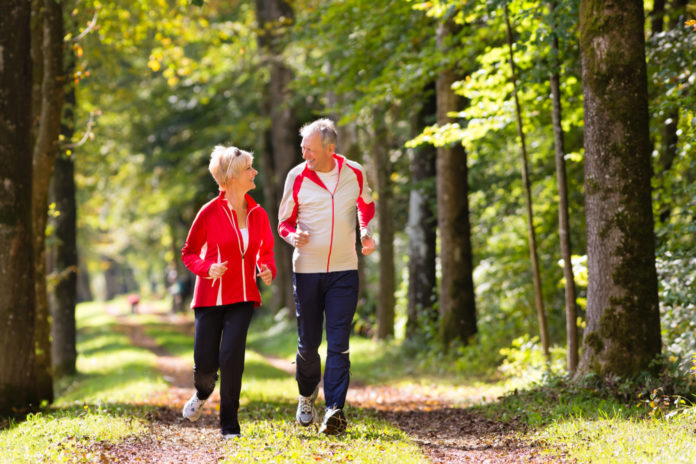While the physical benefits of working out are well-known, there is a strong link between aging and exercise. In reality, including physical activity into your routine has been touted to promote longer, healthier life.
If hoping to reverse aging, exercises may not be able to turn back the hands of time. However, senior fitness can certainly mitigate the effects of aging on the body!
Benefits of Exercise for Older Adults
From supporting heart health to improving memory, senior fitness can truly benefit overall health.
1. Aerobic Exercise for Heart Health
Also known as cardiovascular exercise or simply “cardio,” aerobic exercise is any exercise that elevates heart and breathing rates. While cardio offers many benefits, including weight management and, it is mostly known to support heart health.
Elevating heart rate can help improve blood flow to the heart and lungs and encourage healthy blood pressure levels. Lowering high blood pressure reduces the risk of heart attack, stroke, and dementia.
According to a study in Circulation, two years of exercise improved oxygen uptake in once sedentary healthy middle-aged adults. It also decreased cardiac stiffness, which is a strong predictor of cardiovascular events and mortality.
Regular exercise training may protect future risk of congestive heart failure (CHF) as well.
2. Light Jogging for Longer Living
In addition to supporting heart health, light jogging may extend precious years of life. A 2015 study helped determine the link between jogging dose and long-term mortality.
Researchers evaluated exercise patterns of over 5,000 healthy participants enrolled in the Copenhagen City Heart Study. They found jogging from 1 to 2.4 hours per week was linked to the lowest mortality risk. The optimal frequency of jogging was no more than three times per week, too.
What’s more, the study eventually associated that strenuous joggers were as likely to die as sedentary non-joggers.
3. Walking for Better Memory
In addition to compromised physical fitness, the mind is at risk of declining. Those who keep on walking may enhance cognition and stave from mental decline, especially when it comes to memory.
Researchers from the University of Maryland enrolled 16 healthy elders and another 16 elders diagnosed with mild cognitive impairment to participate. For 12 weeks, participants walked 30 minutes four times weekly at a 50 to 60 percent of heart rate reserve.
Following the intervention, both groups showed an improved ability to remember a list of words. The study also suggested exercise may be particularly useful in those who have already experienced mild memory loss.
4. Resistance Training for Muscle Preservation
As the body changes, seniors tend to lose precious muscle mass while fat mass takes its place. The swap not only causes a slower metabolism but lessens senior strength and increases their risk for falls and injuries.
Fortunately, the effects of aging can be reversed by including resistance and strength training. This especially serves true when paired with a balanced diet with adequate protein.
5. Weight-Bearing Exercise for Bone Support
When it comes to exercising for bone health, the best exercise one can do is the weight-bearing kind. Weight-bearing exercises force you to work against gravity and include weight training, walking, climbing stairs, amongst the many.
Weight-bearing exercise protects against bone density loss, keeping bones strong and reducing fall risk. Seniors should still incorporate calcium and vitamin D sources to support strong bones, taking supplements as needed.
6. Leg Exercises for Edema
Edema is when fluid builds up underneath the tissues and causes swelling. If left unmanaged, changes in the skin, pain, and inflammation can occur. While there are many causes of edema, including kidney disease and CHF, it is a relatively common effect of aging.
Edema severity can be mitigated with leg exercises, including calf and ankle muscle pumps, calf stretches and strengthening, and walking.
7. Swimming for Arthritic Symptoms
When managing arthritis symptoms, the last thing you want to do might be exercising. But most healthcare professionals discourage the notion of “taking it easy” when it comes to effectively managing arthritis.
In reality, physical activity can help mitigate such effects. But unlike strenuous weight-bearing exercises, swimming can be a low-impact, gentle exercise to ease arthritis pain. As an added bonus, weight loss can take excess pressure off the joints and relieve symptoms.
8. Yoga for Emotional Health
The calming and restoring impacts of yoga supports emotional health, including reducing feelings of stress, anxiety, and depression. If negative emotions are left unmanaged, they can transpire to chronic stress on the body and even accelerate the aging process.
Yoga also improves flexibility, balance, and strength, along with supporting heart, bone, bowel, and overall health.
9. Pilates for Back Pain
A majority of older adults suffer from lower back pain. Doing core exercises can help stretch and strengthen the muscles that support the lower back and reduce the pain.
Along with supporting stability and flexibility, pilates targets and activates the core muscles while serving as gentle, low-impact exercise. Attend local classes in the local area or practice this pilates instructional video in the comfort of your own home.
10. Tai Chi for Balance
The fluid, gentle movements of tai chi can strengthen the body and encourage the mind-body connection.
The ancient Chinese practice also helps support and improve balance, which in turn reduces the risk of tripping and falling. This is important to lower the likelihood of injury and preserve independence amongst seniors.
While group classes are generally offered locally, various DVD tai chi programs allow seniors to stay at home. Balance exercises include Dr. Paul Lam’s Thai Chi for Health, as his lessons have been recommended by several reputable organizations.
Overall Benefits of Senior Fitness
Certain types of exercise can lead to many health benefits. Regular physical activity can likewise augment sleep, boost the immune system, and support bowel health.
All-in-all, exercise improves overall health on physical, mental, and emotional levels. Staying active also lowers the risk of and manages chronic diseases such as heart disease and diabetes.
Senior Exercise Ideas & Recommendations
With so many options and advantages, though, you might be wondering which exercise is best. Truly, the answer lies within yourself, as the best exercise is the one you will regularly do.
Fortunately, there are guidelines to help get you geared towards a longer, healthier life as well. These include consulting with a doctor, starting slow, and exercising with a workout buddy.
Consult with Your Doctor
Always talk with your primary care provider before jumping into any new exercise program or regimen.
Working with a physical therapist or personal trainer can also help ensure safe movements to prevent injury and optimize each function.
Start Slow
If new to the exercise scene or have taken a break, start slow into any sort of workout regimen. As you get accustomed to the movements and build strength, increase the frequency and intensity of the routine.
Break Up Physical Activity
General recommendations suggest one should be moderately active for at least 150 minutes weekly. However, one can also meet these guidelines by breaking it into 20 to 30-minute sessions each day.
Activities that count include running, walking, cycling, gardening, and housework. Because, really, any movement is better than going without it!
Avoid Overdoing It
More is not always better, especially when it comes to exercise. Most of the evidence supporting the benefits of exercise call for moderation.
In fact, too much of or intensity can actually increase inflammation within the body. Chronic inflammation can wreak havoc and even jeopardize overall health.
Exercise with a Workout Buddy
Exercising with a workout buddy not only keeps you both accountable but makes the journey more enjoyable and fun!
Also feel free to join a fitness center for senior group classes and other offered fitness programs. Working out in a group can really kick motivation up a notch (or two)!
Have Fun!
Speaking of fun… Exercising does not have to be so serious, despite the serious benefits it offers.
One of the greatest aspects of exercise is the heightening of mood, subsequently enhancing the quality of life!






